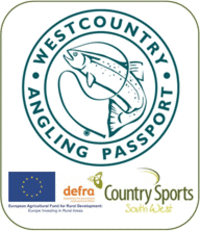Bridgerule, known as Ponsrowald in Cornish, is an English village and civil parish located in Devon, situated approximately one mile from the Cornwall border. The parish is divided by the River Tamar, which no longer serves as the boundary between Devon and Cornwall in that particular area. However, it is worth noting that the river frequently causes flooding along the High Street. The region also encompasses an electoral ward called Tamarside. As per the 2011 census, the population of Bridgerule was recorded at 1,734 individuals. This camera was installed and is maintained by the Environment Agency and can be viewed
here. All content is available under the
Open Government Licence v3.0. Bridgerule holds historical significance, being mentioned as "Brige" in the Domesday Book of 1086 when the local manor was held by a Norman named Ruald Adobed. The name Bridgerule is believed to be derived from a combination of "bridge" and "Ruald." Prior to 1844, the River Tamar acted as the border between Devon and Cornwall, with the western part of the parish falling within Cornwall. However, under the Counties (Detached Parts) Act 1844, West Bridgerule was transferred to Devon. In 1866, when civil parishes were established, East Bridgerule and West Bridgerule became separate entities. Nevertheless, the two parishes were reunited in 1950.The village was served by the Whitstone and Bridgerule railway station, which operated on the line connecting Okehampton to Bude. The station commenced its services in 1898 but ceased operations in 1966.Bridgerule is home to a 15th-century church dedicated to Saint Bridget, similar to Bridestowe, and features a distinctive statue, along with various paintings and carvings within its premises. Notably, the baptismal font within the church dates back to Saxon times, showcasing its historical significance. Emmeline Maria Kingdon, the daughter of the local vicar, was born in Bridgerule in 1817 and went on to become a notable head teacher.The scenic beauty of Bridgerule is enhanced by the convergence of the Tamar, Tavy, and Lynher rivers, forming the Tamar Valley, which has been designated as an Area of Outstanding Natural Beauty. Encompassing an area of approximately 195 km2 (75 sq mi), this region includes the lower Tamar (below Launceston) and its tributaries, the Tavy and Lynher. Although the proposal for the Tamar Valley Area of Outstanding Natural Beauty was put forth in 1963, it was officially designated as such in 1995. One of the prominent landmarks within the AONB is Kit Hill, which stands at an elevation of 334 meters above sea level. Additionally, visitors can explore the captivating Tamar Discovery Trail, a 35-mile hiking route that follows the course of the Tamar through the valley.
The River Tamar, along with the land along its banks, holds several designations, including a Site of Special Scientific Interest (SSSI), a European Special Area of Conservation, and an Area of Outstanding Natural Beauty. Furthermore, a section of the river has been recognized as a UNESCO World Heritage Site, forming part of the Cornwall and West Devon Mining Landscape.


